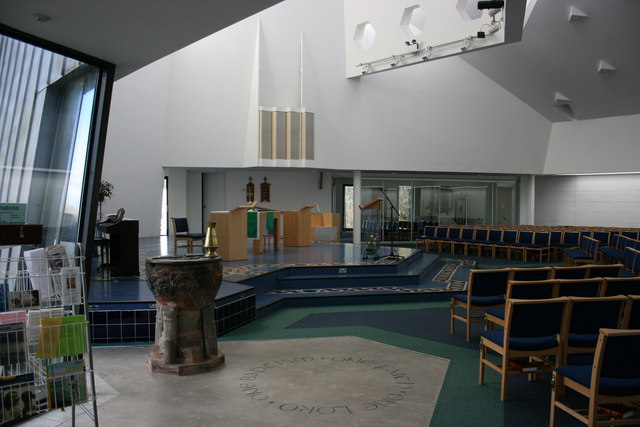 |
| This was not the hospital chapel, but it captures some of its qualities. |
My usual reaction to insipid chapels is annoyance, injury, loathing. Badly proportioned rooms offend my Euclidean mind. Misarranged and temporary furniture imply hastiness and miserliness. Ugly altars, ghastly stained glass, Picasso tabernacles, and Puritan decorations make me want to scream. All these, associated with twenty-minute Masses and liturgical “freedoms,” make me boil.
But as I prayed before Mass, I thought about this reaction. I recalled that I recently learned that there are laws prohibiting things like permanent furniture (e.g. pews) in some of these chapels.
I discovered this at Notre Dame when I was struck by their dedication to consistent architecture. ND’s newer buildings have very similar external architecture to older ones (high-pitch slate roofs, warm brick, stone molding, gothic arches, and statuary). However, chapels in the older buildings are charming, tiny versions of ND’s central gem, the Basilica of the Sacred Heart (below: the basilica's altar); in contrast, chapels in the newer buildings are variations on the insipid chapel. When I observed this to a fellow participant in the Vita Institute, I was told that chapels built into buildings designed for other purposes (e.g. office buildings, hospitals, or dormitories) are restricted. At any time, these chapels must be able to be deconstructed so that the room can used for another purpose. (We will not rant today about such laws; it’s off-topic and I don’t know enough about them.) Certainly this doesn’t excuse everything about these chapels, but it does give me pause.
 Once I had the occasion to reconsider my crusade against insipid chapels, I realized that they have their beauties. I saw an example in my high school experience of an ugly chapel that helped me grow in grace.
My high school had an insipid chapel (before it was converted into a math classroom). It was a small room and the long axis of the room was parallel to the altar. This meant people angled their bodies sharply to face the priest or the Eucharist. The tabernacle was an undecorated octagonal prism of whiteish marble that rose starkly from the ground to the far right of the altar. Above it (in the angled ceiling) was an awkwardly-placed skylight. The sanctuary lamp stood beside it, having nowhere else to hang or rest.
Once I had the occasion to reconsider my crusade against insipid chapels, I realized that they have their beauties. I saw an example in my high school experience of an ugly chapel that helped me grow in grace.
My high school had an insipid chapel (before it was converted into a math classroom). It was a small room and the long axis of the room was parallel to the altar. This meant people angled their bodies sharply to face the priest or the Eucharist. The tabernacle was an undecorated octagonal prism of whiteish marble that rose starkly from the ground to the far right of the altar. Above it (in the angled ceiling) was an awkwardly-placed skylight. The sanctuary lamp stood beside it, having nowhere else to hang or rest.Don’t groan yet! I had not yet experienced real architectural beauty, so I was pre-snobbery. Blissfully unimpeded by the architectural imperfections, I used to go to this chapel to pray the rosary in the mornings. I knelt in front of the chair immediately before the tabernacle, not more than three feet from our Lord.
My imagination transformed the scene. The monolithic tabernacle became the foot of the cross planted in the barren ground of Golgotha. The rest of the cross as well as Our Lord’s body was beyond my physical sight, lit up in sunlight and bathed in mystery. I could only see it in my mind’s eye. The sanctuary lamp, standing beside this cross and placed between me and Christ, became Our Lady. I began to understand the tilt of her head in icons, the place of our Mediatrix in our lives.
Remembering that insipid chapel, I realize something about my attitude toward all ugly chapels. I only stand to gain by receiving others’ works (like their chapels) with meekness.
Important: The “I don’t care what a chapel looks like” attitude is bad. If the house we build for Christ repels, how can we attract others to Him? Moreover, our art reflects our loves; if we love Beauty, we will endeavor to fill our lives with it. If it were in my power to improve an existing chapel or design a new one, I would pour extraordinary beauty into it. I would try to remember the advice of Dr. Thomas Dillon: shortly after the dedication of the Chapel and before his death, I complimented him on the beauty of TAC’s chapel (left, while under construction in 2008). In response, he simply told me that “we should give our best to God.”
However, my attitude of militant dislike or righteous whining may lose me graces, like the understandings I gained about Our Lady’s place in salvation history I received, praying in my high school chapel.
Thank you. I volunteer at a Catholic hospital and was actually a bit ashamed of myself for disliking its windowless,ugly excuse for a chapel. It isn't even a quiet place, as it is partitioned off most of the time, so the hospital can use at least half its portion for training sessions and immunizations. Thank you for inspiring me to see if this lowly volunteer can muster up some interest in others, to re-think the possibilities to "give our best to God."
ReplyDeleteDear Anonymous,
DeleteThank you for generously serving! Hospital volunteers are real reminders of selflessness in places that sometimes seem strangely consumerized. I'm glad I could provoke some thought and I hope that your hospital chapel is dignified with sufficient reverence, especially if the Eucharist is present.
Thanks for reading and enjoy tomorrow's feast of St. Aloysius! God bless you.